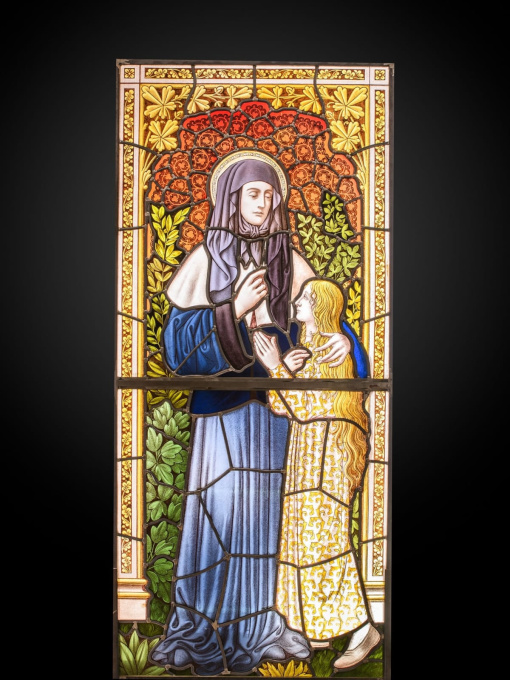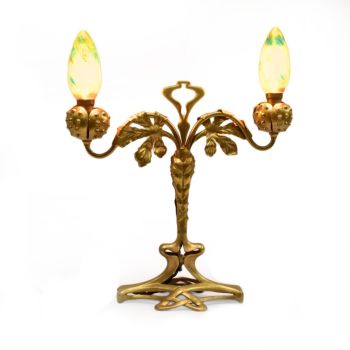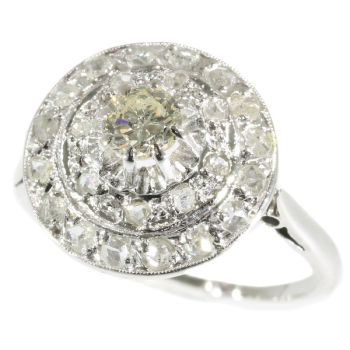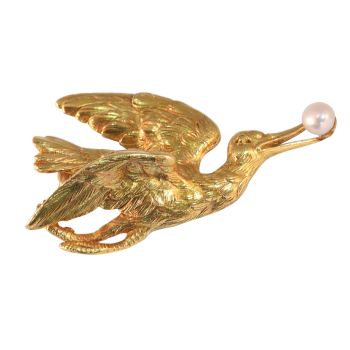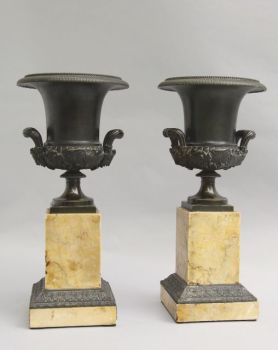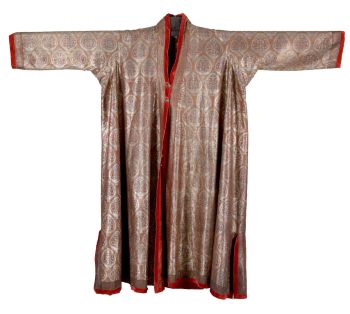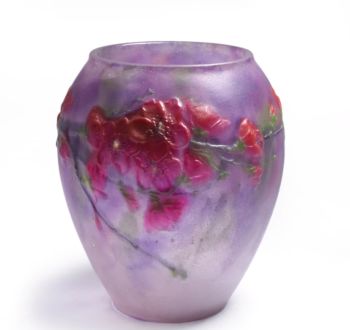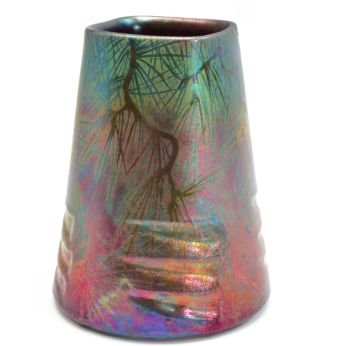EIGHT NEO-GOTHIC STAINED GLASS WINDOWS WITH SUSPENSION EYELET, 19th C, BELGIUM. 1850 - 1900
Artiste Inconnu
VerreVitrail
163 ⨯ 73 cm
Prix sur demande
Spectandum Gallery
- Sur l'oeuvre d'artIn the 19th century, the romantic surge revived interest in medieval art, leading to a renewed admiration for the stained glass windows of Gothic churches. New churches and monasteries were erected in a neo-Gothic style, where stained glass played a crucial role. Stained glass workshops thrived in various Belgian cities, with notable artists such as Jean-Baptiste Capronnier in Schaerbeeck, Samuel Coucke and Henri & Jules Dobbelaere in Bruges, Jean-François Pluys in Mechelen, as well as the workshop of Jean-Baptiste Bethune and Arthur Verhaegen in Ghent. Artists like Charles De Groux and Constantin Meunier also contributed as designers of cartoons for the stained glass. The stained glass in question has been carefully cleaned and placed back in new lead frames, giving it an excellent current condition. A hanging loop allows for easy hanging, and it is also possible to position it vertically.
Saint Nicholas of Bari (born in Patara around 260-270 and died in Myra around 335-337) is known for his generosity towards children, bringing them gifts on December 6th. He is also famous for bringing back to life three theology students who had been murdered by an innkeeper and preserved in a brine container. The two-fingered blessing gesture in his representation refers to the two natures of Christ, divine and human.
Bernard of Clairvaux (born in Fontaines in 1090 and died in Clairvaux in 1153) embraced monastic life at the age of 21 by joining the monastery of Cîteaux in 1112. Endowed with remarkable intellectual abilities and remarkable eloquence, he was tasked by the abbot to found the monastery of Clairvaux. His advice was sought by many ecclesiastical and lay leaders, and he contributed to the expansion of the Cistercian order throughout Europe. Recognized as a Doctor of the Church, Bernard of Clairvaux wrote numerous treaties and sermons, in addition to establishing a new rule for the Knights Templar. His main concern was the discipline of the clergy, which led him to write a spiritual manual for priests and bishops. Considered a genuine mystic, he saw the union of the human soul with God as the ultimate purpose of life. Legend has it that he received a vision of the Virgin Mary offering him her mother's milk to fortify him. In artistic representations, Saint Bernard is usually depicted with an abbot's staff and a book containing the Cistercian rule, reflecting his influence and spiritual contributions. His mystical vision is also a common motif.
Saint Martin (born in Szombathely around 316 and died in Candes around 397) is famous for his act of charity where he divided his cloak in two with a beggar. However, in this stained glass, the artist chose a less common iconographic representation. Saint Martin is depicted as a bishop, wearing a miter and holding an episcopal staff. According to legend, Martin was lured to Tours under false pretenses to be consecrated as bishop. Refusing to assume this ecclesiastical office, he hid in a barn with some geese. However, the birds' chirping betrayed his presence, and he eventually received his episcopal consecration. The presence of a goose at the saint's feet clearly refers to this legendary episode.
Jan Berchmans (born in Diest in 1599 and died in Rome in 1621) was the eldest of five siblings. When his mother fell seriously ill, he initially cared for her, but at the age of nine, he was taken in by the town's priest. After a few years, he went to Mechelen to become a servant to a canon, which also allowed him to begin his studies at the seminary for priests. Later, he joined the Jesuits of Mechelen and obtained their permission to study philosophy in Rome. In the Eternal City, he devoted himself to teaching the faith to children in the popular neighborhoods. He died of illness at the age of 22. Saint Jan Berchmans is now venerated as the patron saint of schoolchildren and students.
Saint Roch (born in Montpellier around 1295-1300 and died around 1327-1380) is famous for being born with a birthmark in the shape of a cross on his left hip, interpreted as a divine sign. After the death of his parents, he distributed his wealth to the poor and went on a pilgrimage, dedicating his life to caring for plague victims. It is said that he healed some of them by making the sign of the cross, earning him the invocation as a protector against the plague.
Saint Clare of Assisi (born in Assisi in 1194 and died in 1253) founded the monastic order of the Poor Clares and became abbess in 1216. She led a life of austerity and isolation from the world with the sisters of her order. When the city of Assisi was threatened by the Saracen army, she fervently prayed before a monstrance for the safety of her monastery and the city, which helped repel the enemy without causing harm. The stained glass represents her with her radiant monstrance.
Charles Borromeo (born in Milan in 1538 and died in 1584) grew up in a noble family and reached remarkable ecclesiastical heights from a young age, becoming cardinal and archbishop of Milan at only 24. His writings played a crucial role in implementing the Church reforms stemming from the Council of Trent. Notably, he published a new catechism and influenced the construction of Baroque churches with his work on the design of religious buildings entitled "Instructiones Fabriacae et Supellectilis Ecclesiasticae." During the plague epidemic that struck his diocese in 1576, Charles Borromeo devoted himself to caring for the sick, earning a reputation for being invoked by those afflicted with serious illnesses.
Angela Merici (born in Desenzano del Garda in 1474 and died in Brescia in 1540), a devoted Italian, taught religion, healthcare, and household skills to young women. She is the originator of the Ursuline monastic community, which played a crucial social role in founding schools and orphanages. Saint Angela died in Brescia in 1540, hence the representation in the stained glass of the saint accompanied by a young girl at her side. - Sur l'artiste
Il peut arriver qu'un artiste ou un créateur soit inconnu.
Certaines œuvres ne doivent pas être déterminées par qui elles sont faites ou elles sont faites par (un groupe d') artisans. Les exemples sont des statues de l'Antiquité, des meubles, des miroirs ou des signatures qui ne sont pas claires ou lisibles, mais aussi certaines œuvres ne sont pas signées du tout.
Vous pouvez également trouver la description suivante :
•"Attribué à …." A leur avis probablement une oeuvre de l'artiste, au moins en partie
•« Atelier de …. ou « Atelier de » À leur avis, une œuvre exécutée dans l'atelier ou l'atelier de l'artiste, éventuellement sous sa direction
•« Cercle de… ». A leur avis une oeuvre de la période de l'artiste témoignant de son influence, étroitement associée à l'artiste mais pas forcément son élève
•« Style de … ». ou "Suiveur de ...." Selon eux, une œuvre exécutée dans le style de l'artiste mais pas nécessairement par un élève ; peut être contemporain ou presque contemporain
•« Manière de… ». A leur avis une oeuvre dans le style de l'artiste mais d'une date plus tardive
•"Après …." A leur avis une copie (quelle qu'en soit la date) d'une oeuvre de l'artiste
•« Signé… », « Daté… ». ou « Inscrit » À leur avis, l'œuvre a été signée/datée/inscrite par l'artiste. L'ajout d'un point d'interrogation indique un élément de doute
• "Avec signature ….", "Avec date ….", "Avec inscription …." ou "Porte signature/date/inscription" à leur avis la signature/date/inscription a été ajoutée par quelqu'un d'autre que l'artiste
Êtes-vous intéressé par l'achat de cette oeuvre?
Artwork details
Related artworks
- 1 - 4 / 12
- 1 - 4 / 24
Artiste Inconnu
UN MODÈLE JAPONAIS D'UN NORIMONO, UN PALANQUIN1650 - 1700
Prix sur demandeZebregs & Röell - Fine Art - Antiques
Artiste Inconnu
UNE COLLECTION DE QUATRE BOÎTES À BIBLE EN IVOIRE SRI LANKAN18th century
Prix sur demandeZebregs & Röell - Fine Art - Antiques
Artiste Inconnu
The Stamford Raffles Secretaires.1800 - 1813
Prix sur demandeZebregs & Röell - Fine Art - Antiques
Artiste Inconnu
UN RARE GRAND TÉLESCOPE EN CUIR LAQUÉ JAPONAIS1750 - 1800
Prix sur demandeZebregs & Röell - Fine Art - Antiques
Artiste Inconnu
UN FILET D'IVOIRE D'UN DUTCHMAN TENANT UN COCKEREL18th century
Prix sur demandeZebregs & Röell - Fine Art - Antiques
1 - 4 / 24Artiste Inconnu
UNE COLLECTION DE QUATRE BOÎTES À BIBLE EN IVOIRE SRI LANKAN18th century
Prix sur demandeZebregs & Röell - Fine Art - Antiques
Marc Chagall
Adam et Eve Chasses du Paradis Terrestre1952 - 1980
Prix sur demandeArthouse Marc Chagall
Marc Chagall
Booz se reveille et voit Ruth a ses Pieds1952 - 1980
Prix sur demandeArthouse Marc Chagall
1 - 4 / 24Artiste Inconnu
François-Théodore Legras – Tall “Fleurs de Pommier” apple blossoms vase1900 - 1909
Prix sur demandeAntiques Emporium
René Lalique
Un très rare vase «Fougères» vert foncé conçu par R. Lalique1912
€ 8.950Lennart Booij Fine Art and Rare Items
 Sélectionné par
Sélectionné parSilla Scheepens
1 - 4 / 24Artiste Inconnu
Pair of 19th C French Taxidermy Dioramas1860 - 1890
Prix sur demandeSpectandum Gallery
Artiste Inconnu
Couple Wooden Ancestors Sculptures with Scarifications, Zela People, DRC. 1920 - 1930
Prix sur demandeSpectandum Gallery
1 - 4 / 12



